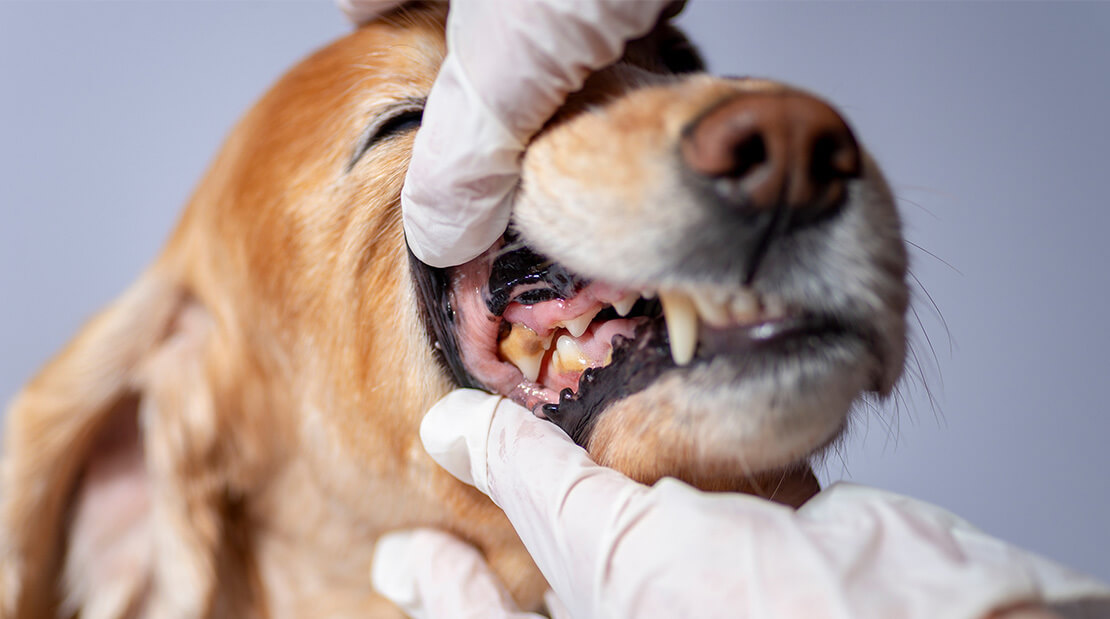
Dental Health for Older Dogs
As our pets age, we may notice behavior that causes concern, such as chattering teeth, rubbing their face on the ground, and/or decreased appetite. These may be signs your pet needs to visit their vet.
Why do my dog’s teeth chatter?
There are many reasons a dog’s teeth may chatter, so the first step to aid in a diagnosis is a dental examination. Reasons may include a viral disease called distemper, neuropathy, tartar buildup, or a foreign object stuck in the tooth such as a stick. Just as every dog is different, there are different reasons for this condition.
What is distemper?
Distemper is a contagious disease that can affect a dog’s respiratory, gastrointestinal, and nervous systems, potentially leading to symptoms like teeth chattering. Administering vaccines as a preventive measure is crucial. But, if your dog unfortunately contacts the virus, your veterinarian will present further treatment options.
Signs of Dental Problems in Dogs
Tartar begins as a thin, invisible layer called plaque. As bacteria replicates, plaque thickens and begins to adhere to the surface of the tooth. This is where bacteria grows, so if you don’t brush often, it becomes mineralized and turns into tartar (the yellow or brown substance on your dog’s teeth). It’s challenging to remove and may require specialized cleaning to do so. This is one of the first signs something is wrong, and it could lead to other dental issues if left untreated.
Other Common Dental Problems in Dogs
When a dog has teeth that are not properly cared for they can develop a dental disease called periodontal disease. The disease has four stages and affects different parts of the mouth, including the gums (gingiva), the bone surrounding the tooth (alveolar bone), hard tissue forming the surface of the root (cementum) and connective tissue of the root (periodontal ligament).
Initially, bacteria irritates the gums causing gingivitis, or stage 1 periodontal disease. This is the only stage that can be reversed with proper dental care and cleaning.
As the disease progresses, it leads to bone loss where the teeth are attached, causing teeth to loosen or fall out. In the early stages, up to 25% of the bone may be lost, but by the time it reaches the later stages, more than half of the bone could be gone, leading to severe pain, swelling, bad breath, and difficulty eating.
What are the brown spots on my dog’s teeth?
When the enamel is eaten away and the dentin is exposed, the likelihood of bacteria entering into your dog’s blood supply is increased. Dentin, located just beneath the tooth’s enamel, envelops the entire pulp cavity. The pulp cavity houses the blood supply and nerves to the tooth. When dentin is exposed, it appears as a brown discoloration to the tooth and has a sticky texture to it when probing during dental examinations. If you observe brown discoloration due to a cracked or broken tooth, it likely indicates a very painful toothache for your pet.
These cracks may also serve as an entry point for bacteria to get into the body of the pet resulting in diseases such as endocarditis, which is an infection of the heart, or even septicemia– an overall infection of the body.
Signs of dental infection in dogs may include:
- Weight loss: Your dog may lose weight because they don’t want to eat.
- Touch aversion: Your pet might not let you touch their mouth because it hurts.
- Trouble chewing: Food falls out of their mouth because they have difficulty chewing.
- Face rubbing: They rub their face against things, which could mean they have mouth pain.
- Swollen gums and jaw: Their gums and jaw might be swollen, indicating a possible tooth root abscess.
- Bad breath: If their breath smells bad, it could be a sign of dental issues.
- Hole in the face: A ruptured abscess can lead to a hole in their face.
- Agitation: They may act agitated because of the pain.
- Reduced activity: Dental problems can make them become less active.
How To Brush Your Dog’s Teeth
Establishing a routine and a familiar spot for daily toothbrushing can make your dog more cooperative. Start by letting them get used to the toothbrush and toothpaste, using treats to encourage positive behavior. When brushing, use dog-specific toothpaste to avoid harmful chemicals. Gently clean each tooth with a dog toothbrush in a circular motion. Remember to cover both front and back surfaces. Reward your dog with water and a treat after brushing.
Daily teeth brushing reduces the risk of dental disease for your pet. It not only prevents dental issues, but also helps you notice any unusual signs like redness or swelling of the gums. If you have any concerns, it’s important to consult your veterinarian.

